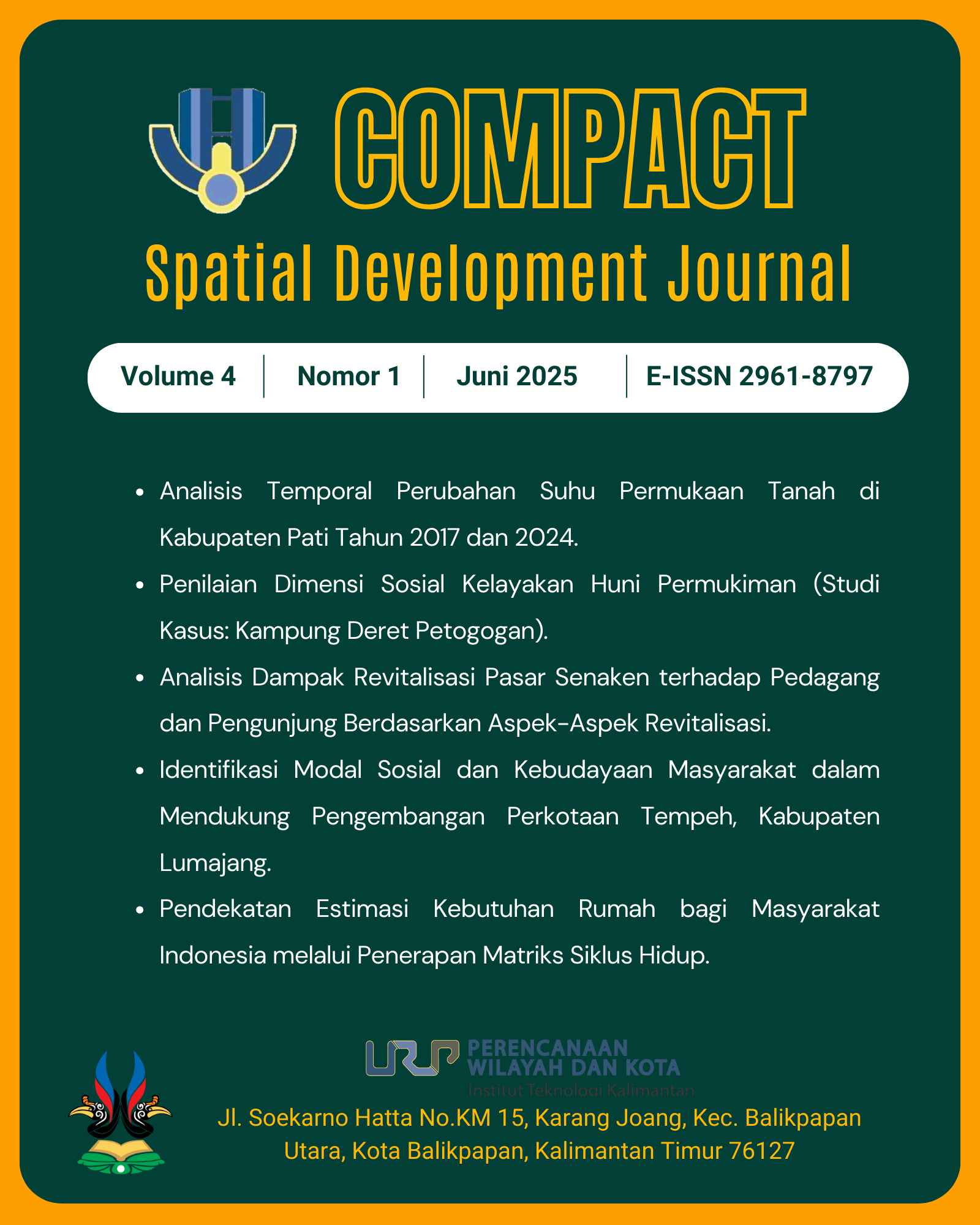Penilaian Dimensi Sosial Kelayakan Huni Permukiman (Studi Kasus: Kampung Deret Petogogan)
DOI:
https://doi.org/10.35718/compact.v4i1.1332Kata Kunci:
indikator sosial, indikator subjektif, kampung deret, layak huni, permukiman layak huniAbstrak
Kelayakan huni atau livability merupakan konsep penting dalam perencanaan perkotaan yang mencakup berbagai aspek, seperti kualitas hunian, akses terhadap infrastruktur, serta kenyamanan sosial dan lingkungan. Di Indonesia, permasalahan berkaitan dengan terbatasnya akses terhadap hunian ayak masih menjadi tantangan, terutama di kota-kota besar seperti DKI Jakarta yang menghadapi pertumbuhan penduduk pesat dan keterbatasan lahan. Untuk mengatasi permasalahan tersebut, pemerintah menerapkan berbagai program revitalisasi permukiman, salah satunya adalah Program Kampung Deret, yang bertujuan meningkatkan kualitas permukiman kumuh melalui perbaikan infrastruktur dan kondisi hunian. Kampung Deret Petogogan menjadi salah satu lokasi penerapan program ini dan telah mengalami berbagai perubahan fisik sejak implementasinya, seperti perbaikan kondisi rumah dan penyediaan infrastruktur. Meskipun program ini telah memberikan dampak positif secara fisik, evaluasi terhadap tingkat kelayakan huni sering kali masih terbatas pada indikator objektif, seperti kondisi bangunan dan ketersediaan fasilitas. Dengan demikian, pendekatan tersebut belum mampu memahami kelayakan huni secara menyeluruh. Padahal, indikator subjektif seperti sense of community, sense of safety, dan partisipasi juga berperan penting dalam menentukan kualitas hidup di suatu permukiman. Oleh karena itu, penelitian ini bertujuan untuk mengkaji kelayakan huni Kampung Deret Petogogan secara lebih holistik dengan dilihat dari indikator subjektif. Dengan pendekatan ini, diharapkan dapat diperoleh gambaran yang lebih komprehensif mengenai efektivitas program serta faktor-faktor yang memengaruhi kualitas kelayakan huni kawasan permukiman. Dari hasil penelitian, diperoleh kesimpulan bahwa Kampung Deret Petogogan menunjukkan potensi sebagai kawasan permukiman yang livable dengan komponen subjektif yang kuat. Temuan ini menekankan pentingnya pemahaman bahwa konsep livability tidak hanya bergantung pada faktor fisik, tetapi juga pada dinamika komponen subjektif yang ada dalam komunitas di kawasan permukiman tersebut
Referensi
Aisyahwati, V. F. (2018). Implementasi Program Kota Tanpa Kumuh (Kotaku) Dalam Upaya Penanganan Kawasan Kumuh (Studi Pada Badan Keswadayaan Masyarakat (Bkm) Kelurahan Gadingkasri Kecamatan Klojen Kota Malang) (Doctoral dissertation, Universitas Brawijaya)
Amin, S., Islam, H. S., Haseeb, A., & Saleemi, A. (2020). Residents⇔ perception of livability: A case study of Quaid-E-Azam Town (Township), Lahore, Pakistan. Planning Malaysia, 18(3), 273–288. https://doi.org/10.21837/PM.V18I13.792
Benita, F., Kalashnikov, V., & Tunçer, B. (2021). A Spatial Livability Index for dense urban centers. Environment and Planning B: Urban Analytics and City Science, 48(7), 2006–2022. https://doi.org/10.1177/2399808320960151
Campbell, A., Converse, P. E., & Rodgers, W. L. (1976). The perceived quality of life and its implications. In A. Campbell, P. E. Converse & W. L. Rodgers (Eds.), The quality of American life (pp. 471–508). New York: Russell Sage Foundation.
Dsouza, N., Carroll-Scott, A., Bilal, U., Headen, I. E., Reis, R., & Martinez-Donate, A. P. (2023). Investigating the measurement properties of livability: a scoping review. Cities and Health, 7(5), 839–853. https://doi.org/10.1080/23748834.2023.2202894
Fahmi, T., Dermawan, M. K., & Harahap, A. A. (2022). Citizens’ Participation in the Effort to Create Security in the Digital Age. International Conference of Humanities and Social Science (ICHSS), 1, 101–109. https://www.programdoktorpbiuns.org/index.php/proceedings/article/view/15
Florencetina, F., & Aditantri, R. (2022). Efektivitas Program Kampung Deret Berdasarkan Indikator Kotaku. Vitruvian : Jurnal Arsitektur, Bangunan Dan Lingkungan, 12(1), 13. https://doi.org/10.22441/vitruvian.2022.v12i1.002
Harahap, T. (2021). Komparasi Indikator Rumah Layak Huni dan Permukiman Kumuh Indonesia. Journal of Science and Applicative Technology, 5(1), 163. https://doi.org/10.35472/jsat.v5i1.426
Hasibuan, F., Lianto, F., Siwi, S. H., & Susetyarto, M. B. (2021). Utilization of public open space in Kampung Deret Petogogan Jakarta. ARTEKS: Jurnal Teknik Arsitektur, 6(2), 189–198. https://doi.org/10.30822/arteks.v6i2.654
Ihwan, M., Fadillah, C., Hidayah, S. N., & Sumardiana, B. (2022). Pemenuhan Hak Atas Rumah Layak Huni Bagi Masyarakat Miskin. Jurnal Pengabdian Hukum Indonesia (Indonesian Journal of Legal Community Engagement) JPHI, 5(1), 89–101. https://doi.org/10.15294/jphi.v5i1.50011
Leby, J. L., & Hashim, A. H. (2010). Liveability dimensions and attributes: Their relative importance in the eyes of neighbourhood residentS. Journal of Construction in Developing Countries, 15(1), 67–91.
McMillan, D. W., & Chavis, D. M. (1986). Sense of community: A definition and theory. Journal of Community Psychology, 14(1), 6–23. https://doi.org/10.1002/1520-6629(198601)14:1<6::AID-JCOP2290140103>3.0.CO;2-I
Namazi-Rad, M.-R., Perez, P., Berryman, M., & Lamy, F. (2012). An Experimental Determination of Perceived Liveability in Sydney. ACSPRI Conferences, RC33 Eighth International Conference on Social Science Methodology, 1–13. https://ro.uow.edu.au/infopapers/2371/
Pan, L., Zhang, L., Qin, S., Yan, H., Peng, R., & Li, F. (2021). Study on an artificial society of urban safety livability change. ISPRS International Journal of Geo-Information, 10(2). https://doi.org/10.3390/ijgi10020070
Setiadi, H., & Rahman, A. (2016). Analisa Keberhasilan Program Kampung Deret Petogogan Menggunakan Pendekatan Evaluasi Pasca Huni. Sosek Pekerjaan Umum, 8 No. 1, 51–61.
Suri, Athaya Eka. (2023). Keberlanjutan Penghidupan Masyarakat Dalam Program Kampung Deret (Studi Kasus: Kampung Deret Petogogan, Kecamatan Kebayoran Baru, DKI- Jakarta) (Tesis, Institut Teknologi Bandung). https://digilib.itb.ac.id/gdl/view/71986/?rows=572&per_page=70
UC Berkeley: (IURD) Institute of Urban and Regional Development.
Ugwu, A. N., & Aruma, E. O. (2019). Community participation as a tool for the promotion of sustainable community development. International Journal of Community and Cooperative Studies, 7(1), 1-10.
Wei, Z., & Chiu, R. L. H. (2018). Livability of subsidized housing estates in marketized socialist China: An institutional interpretation. Cities, 83(July), 108–117. https://doi.org/10.1016/j.cities.2018.06.013
Wheeler, S. (2001). Livable communities: Creating safe and livable neighborhoods, towns, and regions in California.
Wheeler. 2004. Making Cities Livable. International Making Cities
Unduhan
Diterbitkan
Versi
- 2025-10-09 (2)
- 2025-06-30 (1)
Cara Mengutip
Terbitan
Bagian
Lisensi
Hak Cipta (c) 2025 COMPACT: Spatial Development Journal

Artikel ini berlisensi Creative Commons Attribution-NonCommercial 4.0 International License.









